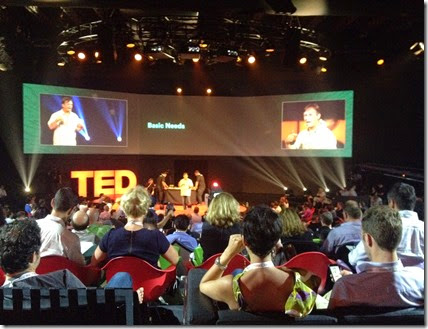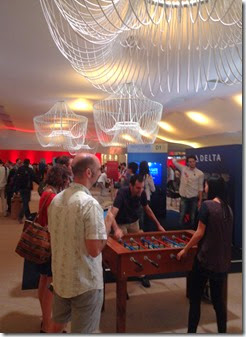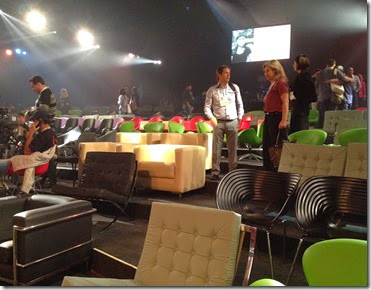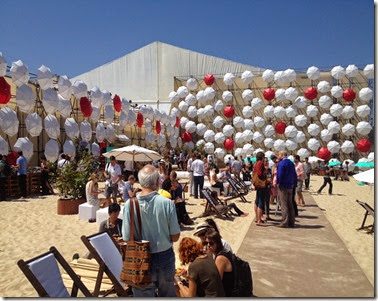 Attending a TED event is like spending 5 days surrounded by shiny objects – great opening lines to speeches, weird facts, interesting turns of phrase, amazing visuals, and those random ideas that you get that are sparked by something that the speaker says, and more – and from amongst all this having to choose what to pick up and take with you. These are some of the shiny things that I picked up this year:
Attending a TED event is like spending 5 days surrounded by shiny objects – great opening lines to speeches, weird facts, interesting turns of phrase, amazing visuals, and those random ideas that you get that are sparked by something that the speaker says, and more – and from amongst all this having to choose what to pick up and take with you. These are some of the shiny things that I picked up this year:
- My top 3 speeches this year were by:
- Melissa Fleming about generations living in refugee camps and why educational opportunities are critical. People in camps have time to prepare for their return – the average time in exile is 17 years! Her question: can refugee camps become centres for academic excellence?
- Glenn Greenwald on why privacy matters – he invited anyone watching who said that privacy didn’t matter to email him all their internet passwords so he could read through everything and publish whatever he wants, and
- Kimberly Motley is a former Miss Wisconsin who is now the only foreign litigator in Afghanistan, focusing on using the laws to protect.
- Privacy speaker and scientist Andy Yen, one of the founders of Proton mail (email encrypted by default), reminds us that our data can and will outlive us. He also mentions the benefits of using the CERN cafeteria to develop an idea – you have 2000 free engineers between 12 and 2pm.
- Joanna Wheeler’s theme was how to use storytelling to stop violence, based on her experience working in South Africa. Her business card was a story cube with her address on it, and the key messages of her talk (in images), printed on a piece of A6 paper that you can cut out and make into the cube.
- The break area of the beach venue (the tent-like auditorium they built from scratch on the Rio beach sand where the talks were held) was filled with different diversions when you want to do something other than think.
- Batalho do Passinho is a new Brazilian street dance out of the favelas of Rio combining the anxiety of fighting with the poetry of dance, and the Bottle Boys are Danish singers/musicians who use only bottles and their voices to cover popular songs. (The Bottle Boys played at one of the evening TEDGlobal parties on the beach in Rio. Their “Call Me Maybe cover got hoots of laughter and lots of applause.)
- I didn’t know that 2/3rds of the population of Sub-Saharan Africa has access to a cell phone signal (one fifth of these people have 3G or better data service). Steve Song’s talk was about not waiting for someone else to “build an on-ramp to the internet”, and the opportunity cost for those without access is skyrocketing as technology comes on and is ubiquitous.
- One speaker, Sipho Moyo, asks, “How do we feed 10 billion mouths? There is no answer that doesn’t involve Africa.” She put up a blank slide, and said it was a picture that hadn’t yet been taken – it was a picture of Africa feeding the world. (She also points out that in the $110b chocolate industry, 70% of the cocoa comes from West Africa”, interesting for a Switzerland-land-of-chocolate-based person like me).
- There’s a new food scanner called Tellspec being developed that you can put next to any food (including baked goods with no labels, etc.) that will tell you the composition of the food.
- Architect Alejandro Aravena used a chalkboard for his talk about participatory design for low cost public housing – they build people half a house and then let the people living in it build the other half in the years that come, to suit their needs and with their own style. This innovative housing project is half the cost (obviously) and fits into the cultural norm in Chile (and many other countries) of building your house little by little over the years.
- The auditorium was filled with different kinds of chairs. Every day you could try a new one and sit upright or sink into a comfy couch.
- Brazilian CEO Ricardo Semler says on Mondays and Wednesdays he “learns how to die”. He calls these his “Terminal Days” and does things he would do if he had gotten news of a terminal illness and didn’t have much time left on earth. He runs a company without “rules” and gives people Wednesdays to do what they would do if they were retired. He ran board meetings with 2 seats for the first two people who showed up, whoever they might be in the company.
- I liked that they gave a pair of Havianas flipflops with the gift bag, along with an Entreposto beach/picnic blanket with grommets so you can tie it down in the wind.
- The Beach area with all the deck chairs and umbrellas was a great place to unwind and reflect on what you heard, and the sand was so hot that you needed those flipflops (if you didn’t want sand in your shoes!)
- Linking the digital with the physical – With a 3D printer they printed a car in 2 days in Manitoba. A Chinese company is printing 5 houses a day for under $5000.
- Bel Pesce’s TED University speech was about 5 ways not to follow your dreams (from believing in overnight success to believing that your goal is the end goal.)
- Journalist Bruno Torturro of MediaNinja opens by asking, “Has anyone has been exposed to tear gas?” He shows the simple molecule that he says is trendy with police and says that it makes your eyes burn and also opens them (in his case to the power of independent broadcast). He has helped create a network of experimental journalists who use mobile equipment to live stream political protests in “post television formats”.
- I have never eaten so much quinoa as I did that week with TEDGlobal in Rio, who knew how many ways you could fix it.
I enjoyed going back through my notes to write this blog post and see what had endured for me a month now from being with TED in Rio. There are plenty of shiny objects still glittering around in my mind!







